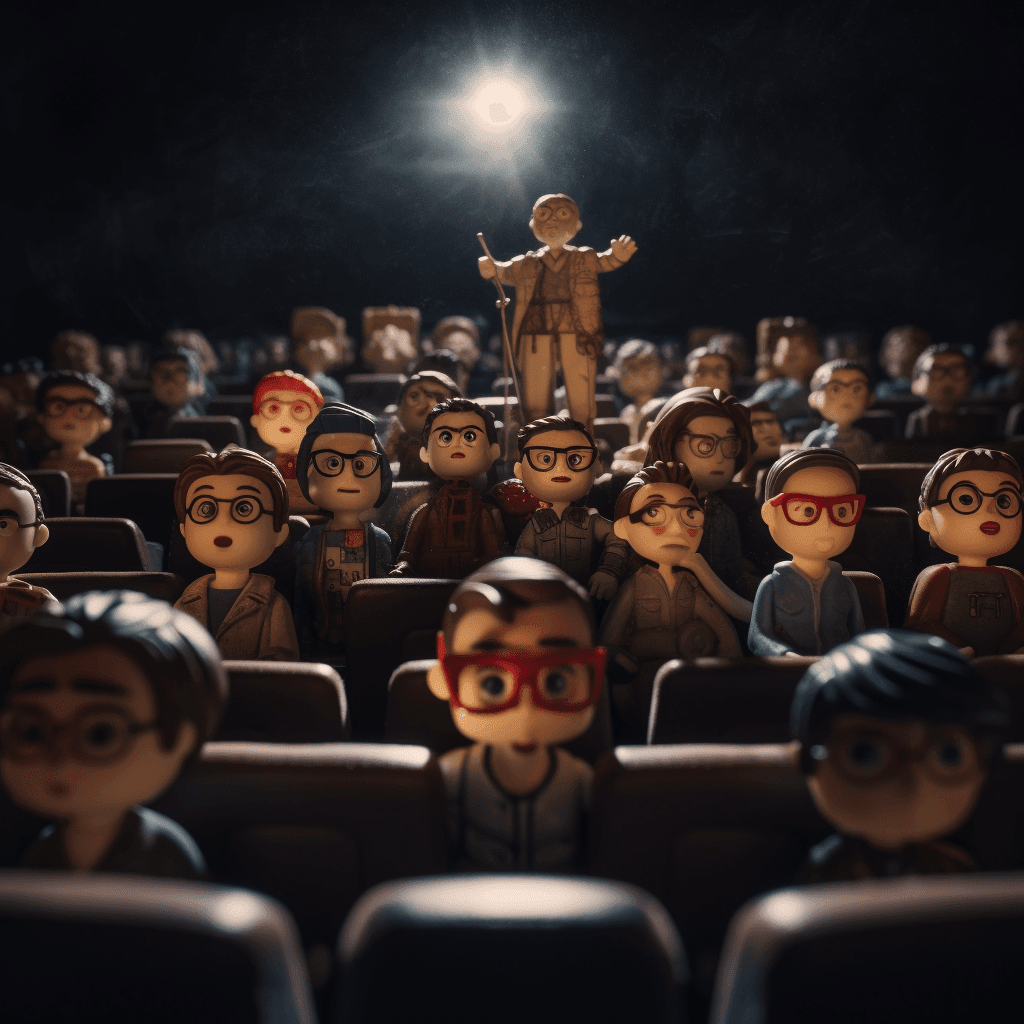Ad Blocker Detected
We use ads to keep this site running, so please consider disabling your ad blocker. Thank you!
Do not know how to disable ad blocker? Check out this article: How to disable ad blocker?
What's After the Blog?
Criticism
Exploring the Intricacies of Film Adaptation
Delve into the art of film adaptation, exploring how books are transformed into cinematic masterpieces, from character development to tackling 'unfilmable' narratives.
July 24, 2024

Movies mentioned in this article
Exploring the Intricacies of Film Adaptation
Introduction
Film adaptations have always been a staple of the cinematic world, weaving complex tapestries that blend the original essence of source materials with the unique vision of filmmakers. The journey from the written word to the silver screen is an intricate process, often layered with creative choices, challenges, and compromises. Whether it’s adapting timeless classics like Pride and Prejudice or bringing to life the vibrant pages of comic books as seen in The Avengers, the art of adaptation requires a delicate balance between staying true to the original material and reimagining it for a new medium. These adaptations can sometimes divide audiences and critics alike - while some laud the faithful representation of beloved books or plays, others celebrate the fresh perspective that a cinematic rendition can bring.
At the heart of every film adaptation lies the challenge of translating a narrative, often bound within the pages of a book, into a visual and auditory experience that captivates the audience. This translation isn’t merely about replicating dialogues and scenes; it’s about capturing the essence, the mood, and the thematic undercurrents of the original work. Consider the adaptation of J.R.R. Tolkien’s epic The Lord of the Rings, where Peter Jackson not only had to be faithful to Tolkien’s richly detailed world but also had to bring it to life for viewers who might have never read the books. It’s a process that requires immense creativity, a deep understanding of both mediums, and, most importantly, a respect for the original material.
The Art of Adapting Source Material
The process of adapting source material for film is a multifaceted endeavor that involves more than just converting text into screenplay. It’s about interpreting, reinventing, and sometimes, completely transforming the original work. When a novel, play, comic book, or even a real-life story is adapted into a film, it undergoes a metamorphosis. The screenplay writer and the director must decide what to keep, what to leave out, and what to add to make the story work on screen.
One of the primary considerations in film adaptation is the length and depth of the source material. Novels like Gone with the Wind or War and Peace are dense with detail and plot, which presents a challenge: what can be trimmed without losing the essence of the story? On the other hand, short stories or plays, like Fences originally written by August Wilson, offer a different challenge – expanding the narrative enough to fill a feature-length film while maintaining the intensity and focus of the original work.
Character development is another critical aspect. In books, readers spend hours, if not days, with characters, understanding their thoughts and motivations. In film, this needs to be achieved in a couple of hours. A character like Elizabeth Bennet in Pride and Prejudice must be as engaging and complex on screen as she is in Jane Austen’s novel, which requires skillful writing and acting.
Then comes the challenge of visual representation. Books allow readers to imagine characters and settings, but films need to present these visually. The fantastical worlds of Harry Potter or the dystopian landscape of The Hunger Games not only had to be faithful to their descriptions in the books but also appealing and believable to the viewers.
Adapting source material for film is not just about what is seen and heard; it’s about recreating the feel, the tone, and the atmosphere of the original work. It’s a complex process that demands a deep understanding of both the source material and the language of cinema.
Balancing Fidelity and Originality
One of the most debated aspects of film adaptation is the balance between fidelity to the source material and the introduction of original elements. This balancing act is crucial, as it often determines the success of an adaptation both critically and commercially. A faithful adaptation, like To Kill a Mockingbird, captures the essence of the source material, translating its themes, characters, and narrative structure to the screen. However, a slavish adherence to the source can sometimes result in a film that feels stilted or uncinematic. On the other hand, adaptations that take significant creative liberties, such as Baz Luhrmann’s The Great Gatsby, can offer a fresh perspective but risk alienating purist fans of the original work.
The question then arises: How did The Harry Potter series balance book fidelity with cinematic creativity? J.K. Rowling’s magical world was richly detailed in her books, providing a solid foundation for the films. The filmmakers, while adhering to the main plot and characters, made creative choices in terms of visual representation, pacing, and even omitting certain subplots for a more streamlined narrative. These decisions were crucial in adapting a series primarily written for young readers into films that appealed to a broader audience, both young and old.
In film adaptations, the director’s vision also plays a significant role. Directors like Peter Jackson with The Lord of the Rings and Alfonso Cuarón with Harry Potter and the Prisoner of Azkaban brought their unique styles and perspectives to the adaptations. They balanced respect for the source material with creative filmmaking, adding their personal touch to the narrative and visual style. This blend of fidelity and originality is what often leads to a film adaptation being celebrated not just as a mere translation of a book to screen, but as a cinematic work of art in its own right.
The Challenges of Adapting Non-Linear Narratives
Adapting non-linear narratives presents unique challenges in film adaptation. Unlike traditional linear storytelling, non-linear narratives can involve complex timelines, multiple perspectives, or fragmented storytelling, which can be difficult to translate effectively onto the screen. A classic example is Cloud Atlas, originally a novel by David Mitchell, which weaves six interconnected stories spanning different time periods and genres. The film adaptation by The Wachowskis and Tom Tykwer had to creatively intertwine these narratives, maintaining coherence and emotional resonance across different timelines.
Similarly, Pulp Fiction by Quentin Tarantino, although not a book adaptation, is an excellent study in handling non-linear storytelling in film. Its narrative is presented out of chronological order, yet it maintains a compelling flow and interconnectivity between its characters and events. For adaptations, this kind of storytelling requires careful scriptwriting and editing to ensure that the audience remains engaged and can follow the plot despite the non-traditional structure.
The adaptation of non-linear narratives also involves deciding how to present the story to maintain its original impact or message. Should the film adhere to the same structure as the book, or would a different approach work better cinematically? For instance, in adapting Life of Pi, director Ang Lee chose to retain the framing device of the novel, which added depth to the narrative and helped translate the philosophical themes of the book effectively on screen.
In adapting these complex narratives, filmmakers must not only consider the technical aspects of storytelling but also how to preserve the emotional core and thematic depth of the source material. This often involves creative solutions and a deep understanding of the mechanics of storytelling in both literature and film. The successful adaptation of non-linear narratives demonstrates the incredible potential of cinema to bring even the most intricate stories to life in a visually compelling and emotionally resonant way.
From Page to Screen: Transforming Characters
The transformation of characters from the pages of a book to the screen is a critical aspect of film adaptation. It’s a process that involves not just physical representation, but also capturing the essence, complexities, and development of each character. Consider the adaptation of iconic characters like Sherlock Holmes. In various film adaptations, from the classic portrayal by Basil Rathbone to the modern reinterpretation by Robert Downey Jr., each version of Sherlock Holmes brings unique traits to the character while maintaining the core elements of Sir Arthur Conan Doyle’s creation. This transformation is crucial in connecting the audience with the characters, especially for those familiar with their literary counterparts.
Adapting a character for film often requires condensing and focusing their traits to fit the medium’s time constraints. In books, characters can be slowly unraveled through pages of internal monologue and detailed descriptions. In contrast, films rely on visual cues and succinct dialogue to convey a character’s personality and growth. The challenge lies in retaining the depth and relatability of these characters. For instance, Elizabeth Bennet’s spirited nature and wit in Pride and Prejudice are effectively captured in film adaptations through keen scriptwriting and expressive performances, ensuring her character resonates with both readers and viewers.
Moreover, casting plays a pivotal role in how characters are perceived on screen. The right actor can bring depth and authenticity to a character, making them come alive in a way that aligns with the audience’s imagination. The casting of Jennifer Lawrence as Katniss Everdeen in The Hunger Games is an example where the actor’s portrayal added layers to the character, complementing the narrative’s themes of resilience and defiance.
The Role of Visual Storytelling in Adaptations
Visual storytelling is the heart and soul of film adaptations. It is through the visual medium that films can explore and expand upon the worlds and themes of their source material. The visual representation of fantastical elements, for instance, is a crucial aspect of adaptations like The Chronicles of Narnia. In these films, the visual effects not only bring to life the magical elements of C.S. Lewis’s books but also enhance the narrative by creating immersive and awe-inspiring landscapes that capture the imagination of the audience.
The use of cinematography, set design, costumes, and visual effects plays a significant role in establishing the tone and atmosphere of a film. A great example is the adaptation of Blade Runner, based on Philip K. Dick’s novel “Do Androids Dream of Electric Sheep?”. The film’s visual style created a dystopian world that was both haunting and visually captivating, setting the tone for the story’s exploration of identity and humanity.
Adaptations of historical or period pieces, like The Great Gatsby, face the challenge of authentically recreating the time period. This involves meticulous set designs, costumes, and props that reflect the era’s essence. The visual portrayal not only serves to immerse the viewer in the story’s world but also to complement the narrative, adding a layer of authenticity and depth to the story.
In conclusion, the role of visual storytelling in film adaptations is multifaceted. It involves a harmonious blend of visual aesthetics and narrative depth, creating a cinematic experience that both honors the source material and stands as a distinct artistic creation in its own right.
Why are Some Books Considered ‘Unfilmable,’ and How Have Filmmakers Tackled This Challenge?
The term ‘unfilmable’ is often attributed to books that are either too complex, abstract, or dense to translate into the visual language of cinema. These are works that rely heavily on internal monologues, intricate narrative structures, or esoteric themes that seem to defy visual representation. A classic example is the novel Life of Pi by Yann Martel. The book, rich in philosophical themes and with much of its action taking place in the protagonist’s mind, was initially considered challenging to adapt into a film. However, Ang Lee’s cinematic adaptation defied these expectations by employing groundbreaking visual effects and a strong narrative focus, turning a seemingly unfilmable book into a visually stunning and emotionally resonant film.
Another approach to adapting ‘unfilmable’ books is reimagining the narrative structure to suit the film medium. This was the case with Cloud Atlas, where the Wachowskis and Tom Tykwer transformed the novel’s complex, interwoven storyline into a more linear narrative while maintaining the book’s thematic essence. Through creative screenplay writing and innovative storytelling techniques, they managed to capture the spirit of David Mitchell’s novel, proving that with enough creativity, no book is truly unfilmable.
These adaptations demonstrate that what makes a book ‘unfilmable’ is not an inherent quality of the text but rather the challenge it poses to conventional filmmaking techniques. Filmmakers who succeed in adapting these challenging works often do so by thinking outside the box, using innovative techniques, and sometimes, by reinterpreting the source material to better fit the visual and narrative style of cinema.
Audience Expectations and Reception
Audience expectations play a significant role in the reception of film adaptations. When a beloved book is adapted into a film, fans often have preconceived notions about how it should look and feel. Meeting these expectations while still creating a film that stands on its own can be a delicate balancing act. The Harry Potter series, for example, had a massive following before the first film was released. The filmmakers were tasked with bringing J.K. Rowling’s magical world to life in a way that satisfied longtime fans while also appealing to new audiences. They achieved this by closely collaborating with the author and carefully selecting cast and crew who shared a passion for the source material.
However, sometimes deviating from audience expectations can be beneficial. The adaptation of The Hunger Games made several changes from the book, including reducing the internal monologue of its protagonist, Katniss. This shift in narrative technique allowed the film to explore its dystopian world more visually, creating a different yet complementary experience to the book.
The reception of a film adaptation can also be influenced by factors such as the film’s marketing, the popularity of the cast, and the general trend in movie genres at the time of its release. Films like The Great Gatsby benefited from a star-studded cast and a soundtrack that appealed to contemporary audiences, creating a buzz that drew viewers beyond the book’s fanbase.
In conclusion, audience expectations and reception are crucial factors in the success of a film adaptation. Filmmakers must navigate these expectations, sometimes adhering to them and other times challenging them, to create a cinematic experience that honors the source material and resonates with both existing fans and new audiences.
Conclusion
The journey of adapting a literary work into a film is a complex and nuanced process that requires a deep understanding of both the source material and the cinematic medium. It’s a balancing act that involves staying true to the original narrative while also breathing new life into it through visual storytelling. Successful adaptations, such as The Lord of the Rings trilogy, not only respect the essence of the original work but also expand upon it, creating a new and enriching experience for audiences. These films stand as testaments to the power of cinema to transcend the boundaries of medium and bring stories to life in new and unexpected ways.
As we continue to witness a growing number of adaptations, it’s clear that this process is not about simply translating a book into a movie. It’s about reimagining and reinterpreting the story to resonate with audiences in a visually and emotionally compelling manner. From the intricacies of character development to the challenges of transforming complex narratives, the art of film adaptation is a testament to the creativity and innovation of filmmakers. It reminds us that every story, no matter how unfilmable it may seem, has the potential to be retold in a way that captivates and inspires.
Invitation to Explore More
We invite you to dive deeper into the captivating world of cinema on our What’s After the Movie (ATM) blog. Here, you’ll find a treasure trove of insights, analyses, and discussions about everything from classic films to the latest blockbusters. Whether you’re curious about the behind-the-scenes magic of movie making, looking for in-depth reviews, or just a film enthusiast eager to learn more, our blog is your gateway to the fascinating universe of films. And remember, if you ever wonder about a movie’s end credit scenes or seek comprehensive information about your favorite films, ATM is your go-to resource. Happy reading, and see you at the movies!
Continue reading

What's After the Movie?
Not sure whether to stay after the credits? Find out!
Check out our other apps:
Actors
Companies
Latest Movies
© 2025 What's After the Movie. All rights reserved.




















